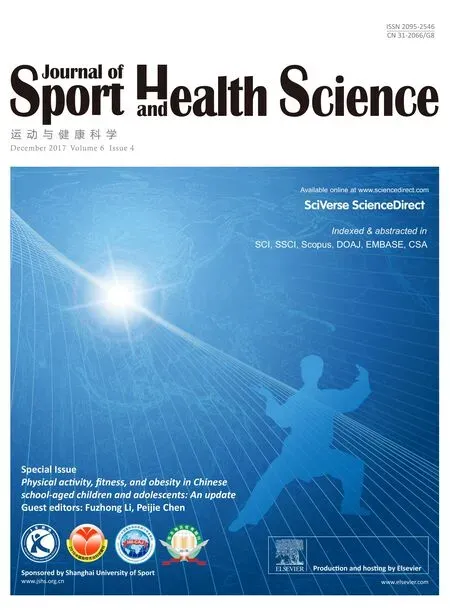Shock attenuation,spatio-temporal and physiological parameter comparisons between land treadmill and water treadmill running
2018-01-08PaulMacdermidPhilipFinkStephenStannard
Paul W.Macdermid*,Philip W.Fink,Stephen R.Stannard
School of Sport&Exercise,College of Health,Massey University,Palmerston North 4474,New Zealand
1.Introduction
Land based,body supported exercise such as running is associated with repetitive strain and stress injuries to the lower extremities.1,2It is hypothesised that these injuries are due,at leastin part,to the shockwave of energy transmitted throughout the body on impact with the ground.2At impact,vertical ground reaction forces of2–5 times greater than body weight with rate of force development of 113 BW/s are observed.3Accompanying the large ground reaction forces,a shockwave of energy is transmitted through the body which must be attenuated to enable proper function of the vestibular and visual systems.4Typically,shock attenuation from the distal tibia to the head is reported as~60%during running with increases of~20%per m/s speed increment.5Whilst anatomical structures provide the greatest potential to attenuate shock via active eccentric muscle action,passive mechanisms such as the elasticity of bone,cartilage,synovial flui,and soft tissue6have an increasing role as muscle fatigue develops.7Additionally,footwear choices,8surface characteristics such as running over uneven ground9or downhill,10and technique(incorporating proprioception,joint position,and muscle tone)can be manipulated to alter individual shock attenuation profiles However,the repetitive nature and load of such impacts,particularly during the support phase,means endurance runners are always going to be susceptible to injury of the lower extremities.4
Unloading forces,expressed in the scientifi literature as effects on total accelerations experienced at the lower limb,6through the hydrostatic pressure of water immersion(Archimedes principle)have been seized upon by the sport and health industry.The reduced impact produced by hydrostatic unloading provides positive adherence to exercise programmes because it can lessen the pain or discomfort experienced4during running and subsequently reduce injury risk.Equally important is the findin that similar cardiovascular fitnes gains can be obtained from aquatic exercise compared to land based activity providing physiological intensity is matched.11
Previously,deep water running has only been used as a means of cross-training or as a rehabilitation process.12However more recently,the benefit of water treadmill exercise,supplementary to normal land based training,have become apparent,4,11particularly,the emphasis on decreased mechanical load on the lower limbs and the diminished risk of injury.However,there are no published data quantifying the level of shock attenuation aquatic treadmill(ATM)running provides when compared to normal land based treadmill(LTM)running;or whether such training affects normal land based running spatio-temporal parameters.Understanding such an influenc would provide useful information to trainers so that they might confident y prescribe supplementary ATM training without incurring additional injury risks.
Therefore,the purpose of this study was to compare shock attenuation,spatio-temporal and physiological parameters during ATM and LTM at a matched speed.We hypothesised that the hydrostatic pressure and resistance to movement during ATM would diminish the required shock attenuation between the tibia and head.This would appear as decreased acceleration magnitude and rate of acceleration development at the anterolateral aspect of the lower leg but not the forehead.Additionally,we hypothesised that stride length(swing time)would increase due to increased buoyancy effect but greater resistance at toe-off due to increased hydrostatic resistance would result in greater ground contact time.
2.Methods
2.1.Subjects
Six nationally competitive middle and long distance runners(age:29.8±13.0 years,height:169.3±7.0 cm,LTM body weight:54.6±5.5 kg,BM I:18.84±0.73 kg/m2,ATM body weight:23.2±4.9 kg;mean±SD),free from injury,experienced at both LTM and ATM participated in this study.The research was approved by the Institutional Review Board of Massey University Human Ethics Committee:Southern A(Application 14/93).A ll participants provided written inform consent in accordance with the University Human Ethics Committee approval.
2.2.Procedures and measurements
The experimental protocol consisted of 2 conditions,each performed within 1 session on the same day in a counter balanced order to prevent any sequence effect on the dependent variables of interest.Both conditions involved running for 15m in on an LTM(TechnoGym,Cesena,Italy)and ATM(O’Leary Engineering,Palmerston North,New Zealand).Each treadmill was calibrated to the same speed(Eq.(1))by using a magnetic switch that was triggered with each belt revolution.The depth of the LTM was set to anterior superior iliac spine level.This offered the least disturbance to arm swing whilst running and has previously been shown to balance the effects of increased resistance with increased buoyancy in terms of work done comparable to LTM.13Water temperature was 21°C in order to alleviate effects of thermal stress.14

On arrival at the laboratory,participants were measured in order to determine the water depth for ATM(height from floo to anterior superior iliac spine(cm))and weighed using hanging scales(PCE Instruments,Southampton,UK).For the water immersed body weight participants were suspended from the scales and immersed to the anterior superior iliac spine.
Following this,participants were fitte with the wireless,tri-axial accelerometers(Emerald;APDM,Portland,OR,USA).These were used to measure accelerations(reported accuracy 0.0012m/s2/√Hz)15of the distal anterolateral aspect of the right tibia,lower back(lumbar)and frontal bone of the head(forehead)at 128Hz(Fig.1).Specifi sites were selected to minimise soft tissue oscillations during impact6and not interfere with gait patterns during ATM running.The accelerometers were packed tightly into a waterproof sport armband housing(H2O Audio,San Diego,CA,USA)and secured tightly.Additionally,participants were connected to a calibrated16automated portable gas analyser(K42b;COSMED,Rome,Italy)that sampled expired air on a breath-by-breath basis,and were also fitte with a heart rate monitor strap(Polar Electro,Kempele,Finland).
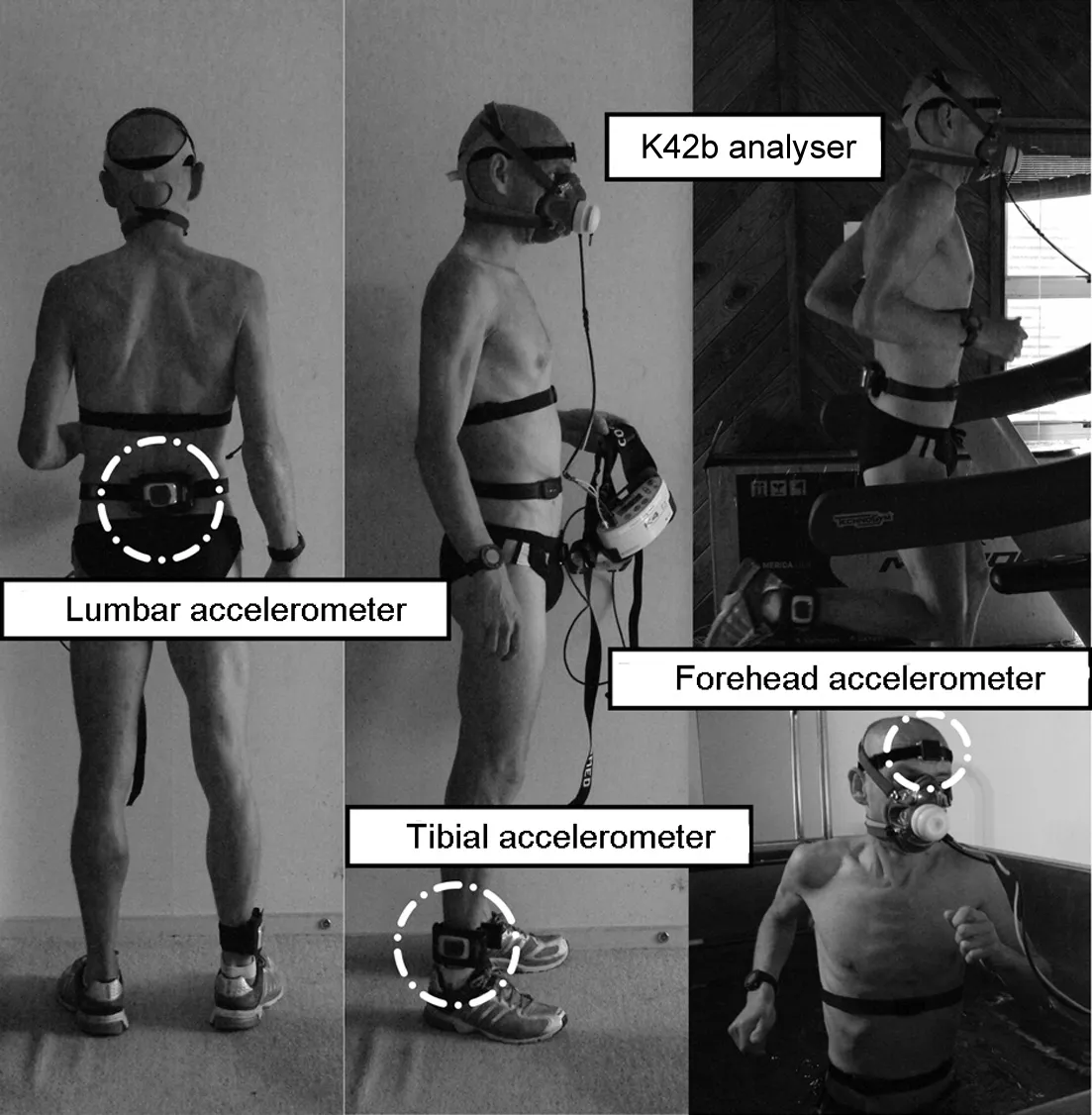
Fig.1.Photographs depicting accelerometer locations and equipment used during the experimental protocol.
All participants completed both tests in shod conditions wearing their normal running shoes.Where the ATM condition was performed first participants used an identical(dry)model of running shoe for the LTM trial.Prior to each data collection period a familiarisation period at speeds below 2.78m/s for 5m in was performed.Following this and immediately preceding the main trial participants ran at 2.83m/s for 2m in.This would eliminate any differences between oxygen kinetics that may occur at the onset of exercise due to water immersion.17The main trials consisted of participants running at 2.83m/s over a 15m in period,and separated by 15min recovery.
2.3.Outcome measures
Synchronised accelerometry data were processed using MATLAB R2014a(Mathworks Inc.,Natick,MA,USA),analyzed for total(XYZ)accelerations(m/s)allowing identifi cation of the precise times of foot contact,peak impact and toe-off for each stride(Fig.2),verifie via high-speed video footage(Exilim Pro EX-F1;Casio,Tokyo,Japan).Algorithms,developed in MATLAB for identifying the peak impact and toe-off accelerations for the leg,and the peak acceleration for the head per gait cycle are explained in the following paragraphs.The algorithms were adjusted until the algorithm matched the visually identifie peaks shown in Fig.2.
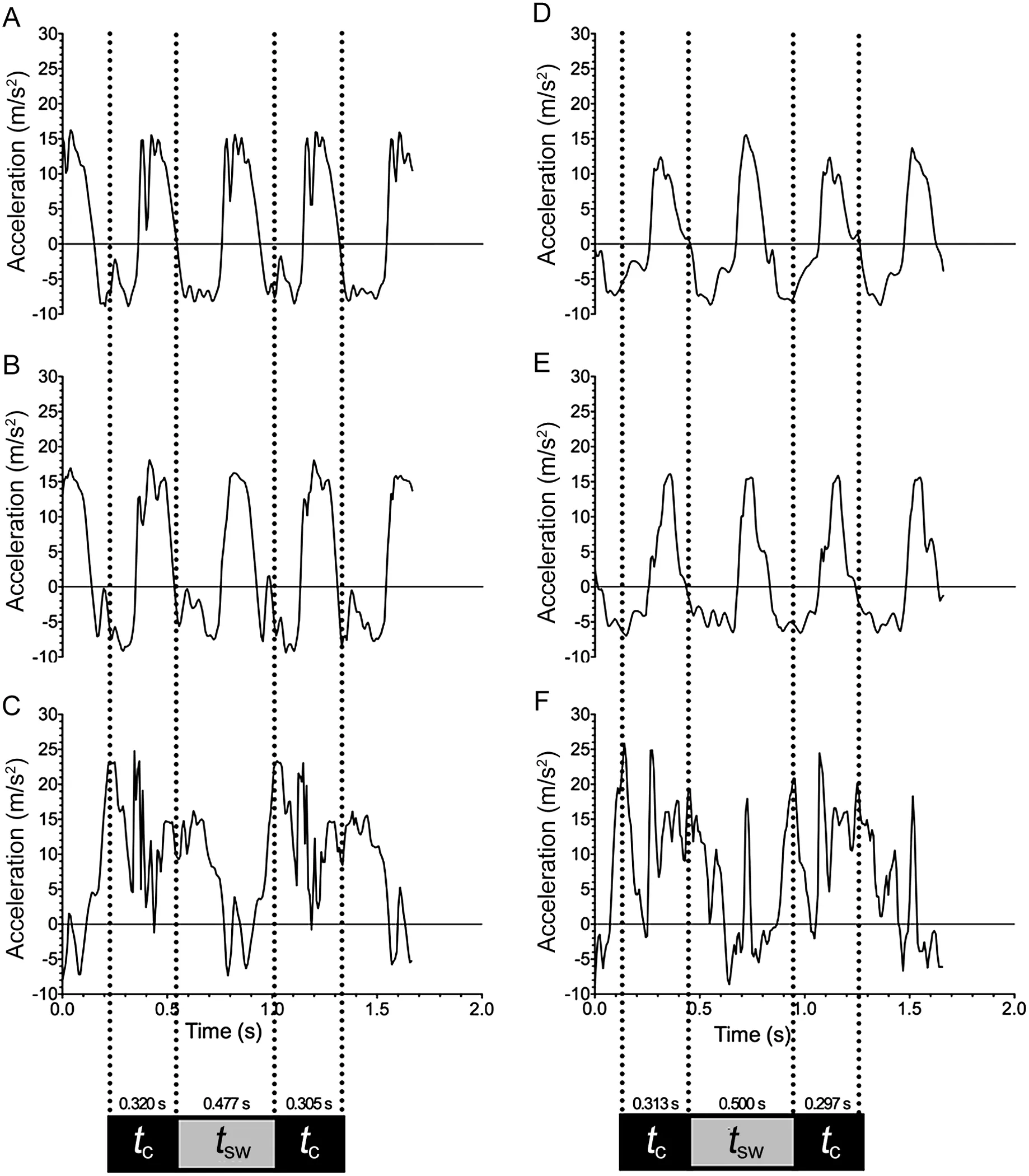
Fig.2.Accelerometer output for total accelerations(XYZ-planes)versus time for Subject5.(A)LTM head;(B)LTM lumbar;(C)LTM ankle;(D)ATM head;(E)ATM lumbar;(F)ATM ankle.Ground contact(t c)and sw ing time(t sw)are highlighted along with peak impact and peak toe-off.ATM=aquatic treadmill;LTM=land treadmill.
The leg total(XYZ)acceleration was analyzed to fin the peak impact and peak toe-off accelerations.For each condition,a threshold of 60%of the maximum acceleration during that condition was used,and the firs point in each gait cycle that exceeded that threshold was identified For the standard treadmill,the peak impact was found by looking for the maximum acceleration in the 10 data points(0.0781 s)following the crossing of the acceleration threshold,and the toe-off peak was found by looking between 8 and 20 points following the crossing of the threshold(0.0625 sand 0.1563 s,respectively).
A different pattern was observed in the water treadmill,with lower peak impacts,requiring a different algorithm.Here the threshold was set at 40%of the maximum acceleration for that condition.The peak impact was identifie as the largest acceleration found between 30 and 4 data points before the crossing of the threshold(0.2344 s and 0.0313 s respectively before the threshold was reached).The peak toe-off was the largest acceleration in the 30 data points(0.2344 s)following the threshold being crossed.
For findin the peak acceleration in the head,the time(taken from the lower leg accelerometer)of the thresholds being crossed for each gait was used.The head peak acceleration was the largest value between 8 points prior to the threshold being crossed for the leg acceleration and 30 points after the threshold was crossed(0.0625 s before and 0.2344 s after,respectively).
Based on the calculated foot strike and toe-off as described above,the following variables were calculated from the accelerometer data:
(1)Transfer function.During the stance phase,whilst the right foot was on the ground,the total acceleration was analyzed in the frequency domain.A fast Fourier transform(FFT)was applied to the total acceleration signal for the head and ankle,giving a power spectral density(PSD).To compare different strides at the same frequencies,the PSD was resampled to 0–32Hz in 2Hz increments.The resampled FFT of the head and ankle was then used to calculate the transfer function(Eq.(2)):4

(2)Ground contact time(tc),define as the time(s)from initial foot contact to the point of toe-off.18
(3)Swing time(tsw)define as the time(s)from toe-off to initial ground contact of consecutive footfalls of the same foot.18
(4)Stride duration define as the time(s)taken for consecutive peak impacts of the same foot.
(5)Stride frequency(Hz),define as the number of strides taken per second.
(6)Stride length(m),calculated by dividing treadmill speed(m/s)by stride frequency(Hz).
(7)Vertical oscillation(cm),calculated from the lumbar accelerometer for each stride between peak impacts.The acceleration was integrated tw ice to get vertical position y(t).This gives the equation:

where a(t)is the acceleration signal with the time set to 0 at each peak impact.
To correct for drift in integration and to account for the unknown initial velocity it was assumed that the vertical height at each impact peak was identical,and arbitrarily set to 0.This implies that:

where T is the time between peak impacts.
Solving Eq.(3)for position to fin c yields

Simpson’s rule was applied for the calculation of integrals and vertical oscillation was define as the range(maximum–minimum)for y(t)during each gait cycle.
(8)Peak impact shock attenuation,calculated(Eq.(6))from the leg(LgPk)and head(HgPk)peak impact accelerations:19,20

where LgPk and HgPk are the peak leg and head accelerations at impact,respectively.
(9)Acceleration loading rate of the leg in relation to the maximum rate of acceleration21,22was taken as the maximum derivative of the leg acceleration in the20 data points prior to the peak impact.
(10)Maximum slope at toe-off is assumed to relate indirectly to the combined effects of force development including elastic recoil.22This is taken as the maximum derivative of the leg acceleration in the 12 data points prior to the maximum acceleration for each foot strike.
Additionally,physiological analysis of expired respiratory gases collected breath-by-breath(K42b)enabled the calculation(CPET suite,Version 10.0e;COSMED)of the body’s rate of oxygen utilisation(VO2,expressed mL/kg/min);the ratio of the carbon dioxide produced to oxygen used(respiratory exchange ratio,RER);the amount of air expired from the lungs during a minute(minute ventilation(VE,L/min));breathing frequency(Rf,breaths/min);and total energy expenditure(ΣEE,kcal).Heart rate was collected and synchronised with the breath-bybreath data and logged for analysis as per respiratory gases.
Spatio-temporal and physiological data were analyzed collectively as a means to determine the efficien y of the 2 conditions via the oxygen consumed per stride(O2per stride,mL).1
2.4.Data analysis
Descriptive data(mean±SD)were calculated for all dependent variables collected continuously throughout the complete 15m in period.Further analysis of all continuous data over 5m in epochs was used to assess for drift amongst variables using two-way analysis of variance(ANOVA,condition×time).Accelerometer data comparisons were made via three-way ANOVA (condition×accelerometer location×time).
Where an overall significan difference was found for the two-way and three-way ANOVAs,posthoc analysis of the main effect was performed using Sidak’s multiple comparison test.All statistical analyses were performed using SPSS Statistics Version 20.0(IBM Corp.,Armonk,NY,USA),significanc was set at p<0.05.
3.Results
Participants completed each 15 m in of running with no(p<0.01)within-condition differences in any of the outcome measures for 5 min epochs indicating there were no technical or physiological changes as a result of either condition.As such the following analyses assess the overall effect of condition(LTM vs.ATM)on performance,and that the data reported below are for the entire 15m in sessions.
3.1.Accelerometry and shock attenuation
Peak accelerations(Fig.3A)experienced at impact revealed significan interactions between condition×location(F(2,11)=202.851,p<0.0001)along with main effect differences for condition(F(1,17)=273.876,p<0.0001)and between accelerometer locations(F(2,17)=358.811,p<0.0001).Post hoc analysis identifie differences for the distal anterolateral aspect of the right tibia(LTM 75.89±10.22m/s2,ATM 23.53±4.15m/s2,p<0.0001)but not the lower back(LTM 21.01±6.84m/s2,ATM 17.39±2.70m/s2,p=0.1363)or forehead(LTM 15.20±2.86m/s2,ATM 12.96±2.74m/s2,p=0.0551).Importantly,the rate of acceleration development at the distal anterolateral aspect of the right tibia was significant y greater on impact(LTM 1649±601,ATM 758±350;t(5)=3.70,p=0.0208)and during toe-off(LTM 1871±905,ATM 1513±613;t(5)=3.70,p=0.0208)during the LTM compared to ATM.
The difference in peak acceleration reported for the lower leg but not the head produced overall significan differences in shock attenuation(LTM 79.62%±4.57%,ATM 42.92%±6.52%;t(6)=14.83,p=0.0001).Two-way ANOVA of time domain analysis data(transfer function)for the stance phase showed a significan interaction(F(32,330)=1.914,p=0.0022)between condition×frequency,with main effect differences for condition(F(1,330)=127.5,p<0.0001)and frequency(F(32,330)=1.651,p=0.0170).Post hoc analysis identifie differences between LTM and ATM only at the high frequency range(>20Hz)typically associated with impact(Fig.3B).
3.2.Spatio-temporal parameters
There was a significan difference for the main effect of condition(LTM vs.ATM)for stride frequency(LTM 1.377±0.033Hz,ATM 1.163±0.081Hz;F(1,12)=38.67,p<0.0001)and consequently stride length(LTM 2.058±0.050m,ATM 2.445±0.158m;F(1,12)=5.716,p=0.0341).LTM had a smaller tswthan ATM(520.8±35.0ms vs.632.3±55.3ms;t(5)=3.327,p=0.0201),but no differences were seen for either tc(207.2±38.4 ms vs.234.1±43.9ms;t(5)=1.137,p=0.3072)or vertical oscillation(0.128±0.025m vs.0.119±0.020m,t(5)=0.7074,p=0.5109).
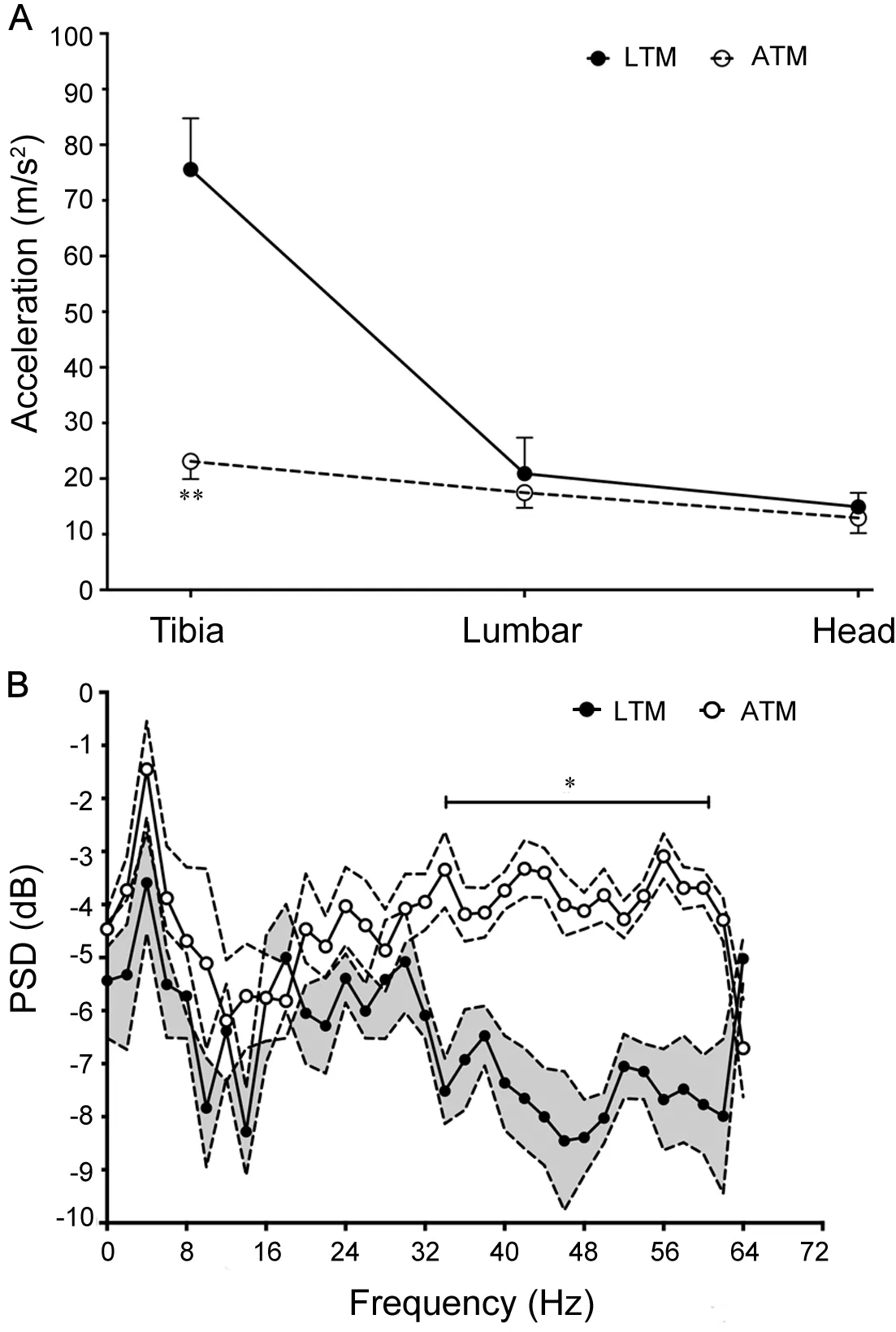
Fig.3.(A)Acceleration at impact for the 3 different accelerometer locations;and(B)transfer function for ground contact time averaged over10 strides from each participant,for each condition(mean±SD).*p<0.05,**p<0.0001,signifie post hoc differences between conditions at specifi time points.ATM=aquatic treadmill;LTM=land based treadmill;PSD=power spectral density.
3.3.Physiological variables
Two-way ANOVA showed no interaction(p>0.05)between time×condition for all physiological variables and no main effect of time.However,there were significan main effects of condition for all variables except breathing frequency(Table1).
4.Discussion
The aim of this study was to compare shock attenuation,spatio-temporal and physiological parameters during LTM and ATM running at the same speed.The main finding were:(a)shock attenuation was considerably lower during ATM running,particularly at higher frequencies;(b)accelerations were significant y greater at the anterolateral aspect of the tibiacompared with those located at the lower back and head during LTM,but not ATM;(c)stride frequency was significant y slower,whilst stride length was significant y longer during ATM due to a greater swing time;and(d)ATM running increased physiological demand compared to LTM.
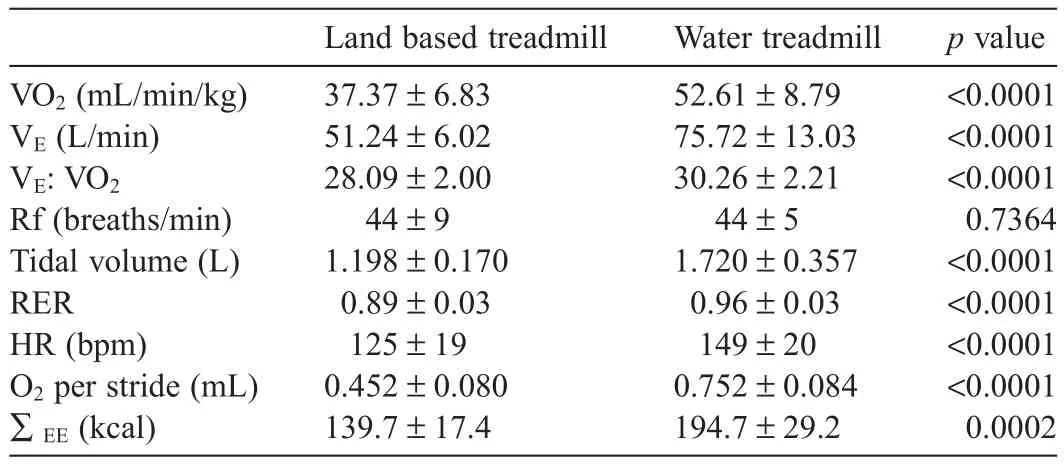
Table1 Statistical outputs for two-way ANOVA main effect comparison of condition for physiological variables(mean±SD).
All of the variables studied were constant over time,with no significan main effects of time or interactions with time.This suggested running technique was not altered during the course of the experiment.This is important,as any differences obtained within the ATM condition will reflec stability following long-term application in regard to effica y as a rehabilitative or supplementary training process.
During ATM there was a decrease in both peak acceleration(Fig.3A)and the rate of acceleration development at the distal tibia.As the impact accelerations were so greatly diminished,less shock had to be attenuated between the tibia and head(36.7%±5.5%)during ATM when compared to LTM.This is important from the perspective of injury prevention,particularly for athletes participating in high volume training in a non-body weight supported mode.In these activities the magnitude of impact is associated with overuse of soft tissue structures5as the shock wave of energy must be attenuated prior to reaching the central nervous system and brain.4This attenuation occurs at high frequencies during LTM running and is associated with ground impact.6,23As such the reduction of accelerations shown during ATM(Fig.3A)means that attenuation was considerably reduced at high frequencies associated with impact(Fig.3B).This unequivocally confi ms the benefi of ATM as a mode of weight-bearing exercise,minimising impact related stress through increased buoyancy,and the hydrodynamic resistance to movement.
The theory of body weight reduction following water immersion has long been understood.According to Archimedes principle,the upward net force of the body(buoyancy),partially or fully submerged,is equal to the weight of the water that the body displaces,whilst the downward force is simply body weight.As such,the net downward force is reduced during the ATM trial due to increased buoyancy.
Similar body weight changes as those presented in this study have previously24shown much smaller changes in ground reaction forces.However,the data presented in Fig.3A highlight significan differences between LTM and ATM for accelerations at impact,reflectin considerable increases in drag forces,thus supporting the importance of the velocity of the foot at impact,on ground reaction force exposure levels previously observed in land based research.5
The decreased acceleration at impact and therefore limb movement velocity is reflecte by decreased stride frequency and increased stride length.As such,the addition of hydrodynamic resistance to movement during ATM running caused participants to alter spatio-temporal parameters.These adaptations are indicative of positive and negative changes to normal land based running speed.6However,the ATM speed was kept constant and such changes(decreased stride frequency and increased stride length)are major contributors towards lower impact acceleration and consequently decreased attenuation.
The observed increase in stride duration as a result of greater swing time for the ATM condition is unusual.Typically,under LTM conditions,any stride length increase is associated with increases in force development and ground contact time.In the ATM condition this would likely result in greater vertical oscillation,distance travelled per stride,and increased utilisation of stretch-shortening energy conservation such as in the case of a more “loping”running style.However,the rate of acceleration development at toe-off during ATM was significant y less than LTM.This intimates that the artificia alteration to stride length(0.387±0.151m)during the ATM centres around the buoyancy effects of water immersion and the z-forces exerted to oppose gravity during ground contact which normally equals body weight.25In this respect,less force application would suggest that the metabolic cost of running in the ATM would be less than LTM.18Our finding disagree on both fronts as the nonsignifican difference(−9 ± 3mm)for vertical oscillation during ATM and an overall decrease in running economy during ATM suggest that reductions in work done to overcome gravity as a result of increased buoyancy do not offset that required to overcome hydrodynamic resistance to limb movement(Table1).
Mechanically,such results mean ATM could lessen the strain on anatomical structures via decreased eccentric loading across the hip,knee,and ankle joints typical of peak impact phases during LTM running.6,7The result of this probable loss of energy conservation during stretch-shortening(normally~65%on land26)means decreased economy of gait.The latter is supported through combining spatio-temporal with physiological data.Specifical y,O2per stride and ΣEE(Table 1)confi m significan decreases in economy during ATM.However,the ground reaction time which was not different suggests that elastic energy was not dissipated in the tissues,but perhaps in the surrounding environment(water).Nevertheless,the reduction of energy conservation means an increased demand on the muscles involved in the propulsive phase27prior to toe-off,and knee extension during the swing phase in order to overcome the resistive forces of the water.28Interestingly,the rate of acceleration development at toe-off was not different amongst our participants for the 2 conditions.Considering the extra resistance encountered during ATM,this indicates greater muscle unit recruitment during this(concentric)phase of gait in this mode.Therefore,the added-mass effect due to hydrodynamic resistance is more plausible for both the increase in HR and O2.The O2results for the LTM(3.66mL/kg·km/h)agree with traditional metabolic calculations29associated with LTM running at 10.2 km/h,whilst the ATM values were 141%greater(5.16mL/kg·km/h).This(ATM)value equates to an estimated LTM running speed of~14.2 km/h,29and suggests that athletes using ATM as training method should use HR combined with speeds~72%of LTM training.
5.Conclusion
The results of the present study confi m our hypothesis that water immersed ATM running significant y reduces shock attenuation compared to LTM running at the same speed.Importantly,this was shown to be a direct result of reductions in accelerations experienced at the lower limb,typically associated with a multitude of overuse running injuries.In addition,spatio-temporal parameters for ATM highlight significant y lower stride frequency,greater swing time per stride as a result of both hydrostatic resistance and increased buoyancy.The balance between these2 factors resulted in an increase in physiological demand which combined with the shock attenuation data implies ATM is a valuable training mode for runners.
Authors’contributions
PWM conceived of the study,carried out data collection and data analysis,and drafted the manuscript;PWF assisted in data analysis and helped to draft the manuscript;SRS helped to draft the manuscript.All authors have read and approved the fina version of the manuscript,and agree with the order of presentation of the authors.
Competing interests
The authors declare that they have no competing interests.
1.Rutledge E,Silvers WM,BrowderK,Dolny D.Metabolic-cost comparison of submaximal land and aquatic treadmill exercise.Int J Aquat Res Educ 2007;1:118–33.
2.Mercer JA,Devita P,Derrick TR,Bates BT.Individual effects of stride length and frequency on shock attenuation during running.Med Sci Sports Exerc 2003;35:307–13.
3.Munro CF,Miller DI,Fuglevand AJ.Ground reaction forces in running:a reexamination.J Biomech 1987;20:147–55.
4.Hamill J,Derrick TR,Holt KG.Shock attenuation and stride frequency during running.Hum Mov Sci1995;14:45–60.
5.Mercer JA,Vance J,Hreljac A,Ham ill J.Relationship between shock attenuation and stride length during running at different velocities.Eur J Appl Physiol 2002;87:403–8.
6.Derrick TR,Hamill J,Caldwell GE.Energy absorption of impacts during running at various stride lengths.Med Sci Sports Exerc 1998;30:128–35.
7.Voloshin AS,Mizrahi J,Verbitsky O,Isakov E.Dynamic loading on the human musculoskeletal system—effect of fatigue.Clin Biomech(Bristol,Avon)1998;13:515–20.
8.De Wit B,De Clercq D,Aerts P.Biomechanical analysis of the stance phase during barefoot and shod running.J Biomech 2000;33:269–78.
9.Müller R,Ernst M,Blickhan R.Leg adjustments during running across visible and camouflage incidental changes in ground level.J Exp Biol 2012;215:3072–9.
10.Gottschall JS,Kram R.Ground reaction forces during downhilland uphill running.JBiomech 2005;38:445–52.
11.GreeneNP,Greene ES,Carbuhn AF,Green JS,Crouse SF.VO2prediction and cardiorespiratory responses during underwater treadmill exercise.Res Q Exerc Sport2011;82:264–73.
12.Reilly T,Dowzer CN,Cable NT.The physiology of deep-water running.J Sports Sci2003;21:959–72.
13.Gleim GW,Nicholas JA.Metabolic costs and heart rate responses to treadmill walking in water at different depths and temperatures.Am J Sports Med 1989;17:248–52.
14.Barbosa TM,Marinho DA,Reis VM,Silva AJ,Bragada JA.Physiological assessment of head-outaquatic exercises in healthy subjects:a qualitative review.J Sports Sci Med 2009;8:179–89.
15.Macdermid PW,Fink PW,Stannard SR.Transference of 3D accelerations during cross country mountain biking.J Biomech 2014;47:1829–37.
16.Thomas C,Hanon C,Perrey S,Le Chevalier JM,Couturier A,Vandewalle H.Oxygen uptake response to an 800-m running race.Int J Sports Med 2005;26:268–73.
17.Shiojiri T,Shibasaki M,Aoki K,Kondo N,Koga S.Effects of reduced muscle temperature on the oxygen uptake kinetics at the start of exercise.Acta Physiol Scand 1997;159:327–33.
18.Chapman RF,Laymon AS,Wilhite DP,McKenzie JM,Tanner DA,Stager JM.Ground contact time as an indicator of metabolic cost in elite distance runners.Med Sci Sports Exerc 2012;44:917–25.
19.Stanitski CL.Common injuries in preadolescent and adolescent athletes recommendations for prevention.Sports Med 1989;7:32–41.
20.Mercer JA,Dufek JS,Mangus BC,Rubley MD,Bhanot K,Aldridge JM.A description of shock attenuation for children running.J Athl Train 2010;45:259–64.
21.Nigg BM,Liu W.The effect of muscle stiffness and damping on simulated impact force peaks during running.J Biomech 1999;32:849–56.
22.Hreljac A,Marshall RN,Hume PA.Evaluation of lower extremity overuse injury potential in runners.Med Sci Sports Exerc 2000;32:1635–41.
23.Shorten MR,Winslow DS.Spectral analysis of impact shock during running.Int J Sport Biomech 1992;8:288–304.
24.Frederick EC,Hagy JL.Factors affecting peak vertical ground reaction forces in running.Int J Sport Biomech 1986;2:41–9.
25.Kram R,Taylor CR.Energetics of running:a new perspective.Nature 1990;346:265–7.
26.Farley CT,Gonzalez O.Leg stiffness and stride frequency in human running.J Biomech 1996;29:181–6.
27.He JP,Kram R,McMahon TA.Mechanics of running under simulated low gravity.J Appl Physiol 1991;71:863–70.
28.Kato T,Onishi S,Kitagawa K.Kinematical analysis of under water walking and running.Sports Med Train Rehabil 2001;10:165–82.
29.Glass S,Dwyer GB,American College of Sports Medicine.ACSM’s metabolic calculations handbook.Philadelphia,PA:Lippincott Williams&Wilkins;2007.
杂志排行
Journal of Sport and Health Science的其它文章
- The effects of aerobic exercise training on oxidant-antioxidant balance, neurotrophic factor levels, and blood-brain barrier function in obese and non-obese men
- Footfall patterns of a runner with an Achilles tendon rupture
- Three-dimensional impact kinetics with foot-strike manipulations during running
- Tribulus terrestris extracts alleviate muscle damage and promote anaerobic performance of trained male boxers and its mechanisms:Roles of androgen,IGF-1,and IGF binding protein-3
- Heart rate variability to assess ventilatory thresholds in professional basketball players
- The influenc of different exercise intensities on kicking accuracy and velocity in soccer players
